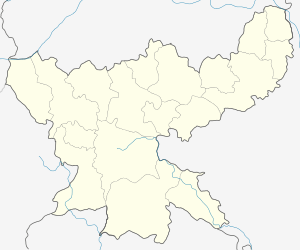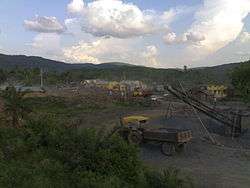Pakur
| Pakur पाकुड़ | |
|---|---|
| City | |
|
A Stone crushing unit in Pakur | |
 Pakur  Pakur Location in Jharkhand, India | |
| Coordinates: 24°38′N 87°51′E / 24.63°N 87.85°ECoordinates: 24°38′N 87°51′E / 24.63°N 87.85°E | |
| Country |
|
| State | Jharkhand |
| District | Pakur |
| Area | |
| • Total | 8.48 km2 (3.27 sq mi) |
| Population (2011) | |
| • Total | 45,840[1] |
| • Density | 5,405.7/km2 (14,001/sq mi) |
| Languages | |
| • Official | Hindi, Santali |
| Time zone | IST (UTC+5:30) |
| PIN | 816107 |
| Telephone code | +91-06435 |
| Vehicle registration | JH |
| Website |
www |
Pakur (Hindi: पाकुड़; previously known as Pakaur) is the district headquarters of Pakur District (पाकुड़ जिला), Jharkhand state, India.
It is located in the north east corner of Jharkhand State: at 23°40' to 25°18' latitude and 86°25' to 87°57' E. longitude. Pakur is bordered by Sahibganj district in North, Dumka district in South, Godda district in West and Murshidabad and Birbhum districts (of the West Bengal) in the East. Pakur District has an area of about 696 square kilometres and a population of 899,200 (2011 Census).
Pakur was earlier a Sub-Division of Santhal Parganas district of Bihar. It was upgraded to the status of district in 1994. Upon reorganization of Bihar state, India, in 2000 into two separate states, namely, Bihar and Jharkhand, Pakur district came under the administrative control of the Jharkhand state.
Geography
At Pakur, the river Ganges, flowing south-southeast, begins its attrition with the branching away of its first distributary, the Bhāgirathi-Hooghly, which later joins with other tributaries to become the Hooghly River.
Demographics
As of 2011 India census,[2] Pakur had a population of 899,200. Males constitute 53% of the population and females 47%. Pakur has an average literacy rate of 50.17%, lower than the national average of 74.4%: male literacy is 59.02%, and female literacy is 41.23%. In Pakur, 16% of the population is under 6 years of age. Traditionally, Pakur has been the land of Santhals and Mal Paharia Adivasi people. However, over a period of time, demographic composition has gradually changed and the local folks have come to the mainstream of the Indian society. Pakur Railway Station is located on the Sahibganj Loop.
Economy
The economy of the district is predominantly agricultural. The district is also endowed with mineral wealth like black stone, fire clay and coal. However, infrastructural constraints have inhibited the growth of mining and allied industries.
One of the main businesses of the city is mining and crushing. It is also known for the manufacturing of crushing and screening equipments. Pakur is also the place where the first indigenous Jaw Crusher was manufactured by Bhagwati Prasad Agarwalla.
Since last decade there has been an enormous activity of coal excavation in the area as well. It has one of the biggest reserves of coal in the world. Currently only one block of coal is active in the region. It has been allotted to the Punjab State Government for their captive Thermal Power Plants. The excavation work on behalf of the Punjab State Government is being done by PANAM. It is a private - public joint venture between Punjab Government and AMTA.
Education
Pakur has educational institutions offering all levels of education, including Pakur Raj High School (Estd. 1852) and Kumar Kalidas Memorial College.
